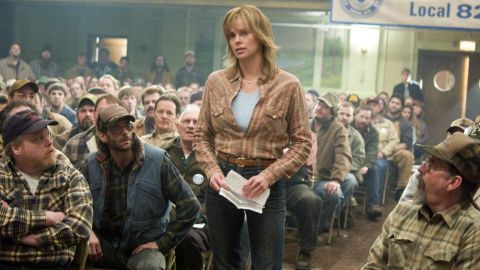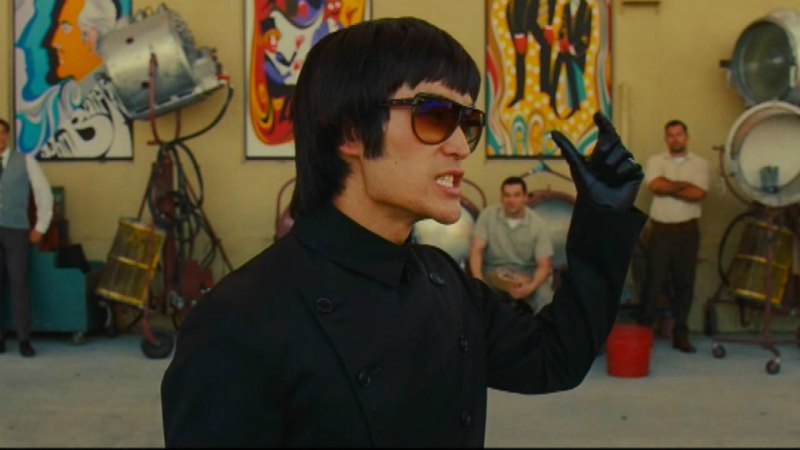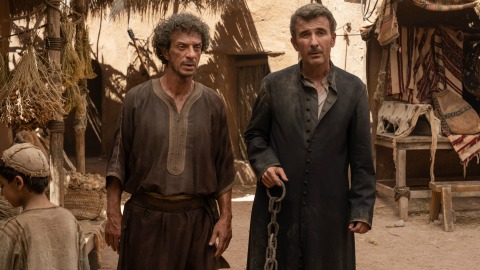
DB and KT, front row center, at the screening of The Lighthouse. Photo by Shelly “Sales Agent Cinema” Kraicer.
DB here:
Storytelling cinema depends on characters, and our relations to them. At the level of individual scenes, we can be more or less restricted to what they experience; we can know as much as they do, or more, or less. Across a film, the filmmaker can attach us consistently to one or two characters, or instead roam freely among many viewpoints. And within a scene, the filmmaker’s choice of camera placement can put us “with” one character or another.
In other words, narrative cinema 101. But it’s worth remembering that these are forced choices. As a filmmaker, you can have restricted or unrestricted access to characters, but at every moment you have to choose one or the other. How objective or subjective will you make your presentation? Will you limit your camera setups or go for ubiquity–that tendency to give us shots divorced from the immediate situation? Examples are a drone-delivered image above a city, or that sudden high or low angle that calls our attention to a detail the characters may have missed.
Three films at the Vancouver Film Festival presented a nice menu of attachment options–ways in which we can be tied to our protagonist. All are well worth your attention, so without getting too much into spoilers, I’ll use them as an occasion to study how these forced choices are handled creatively.
The party’s over

Take as a midrange example The Realm (El Reino, 2018), a Spanish political thriller directed by Rodrigo Sorogoyen. Manuel López Vidal is a brisk, no-nonsense functionary enjoying the good life thanks to the corruption of his party. He and his colleagues, the Amadeus Group, meet regularly over expensive meals to plan their schemes of influence-peddling and money laundering. They tease their fastidious accountant about his meticulous ledgers, but those records will become important to Manuel when one colleague leaks incriminating audio tapes of Manuel’s dealmaking. There’s an orgy of document shredding, damage control among the party’s top brass, and the growing likelihood that Manuel will go to jail.
The screenplay restricts nearly all the action to Manuel. This method is established at the start, when a long tracking shot follows him from the beach as he strides into an Amadeus lunch. Thereafter, we’re with him as he learns of the danger he’s in and mounts one tactic after another to save himself. At a couple of moments the camera lingers on his colleagues’ reactions after he’s left the scene, but on the whole we’re firmly attached to him. Some virtuoso long takes, including a ten-minute shot that follows Manuel’s frantic search for the ledgers, virtually fetishize our adhesion to the protagonist.
By and large, the presentation doesn’t delve into his mind. The throbbing techno score conveys his growing panic as he strides from one confrontation to another, but we get no voice-overs, or flashbacks, or mental imagery. And we don’t see Manuel confide his plans to others (although he seems to have told his wife some of them offscreen). This degree of objectivity allows more suspense, as his schemes to save himself unfold in the moment. We must figure out why he’s bracing one colleague, or bursting into a friend’s home in the course of a teenage party. His manic resourcefulness is all the more impressive when he keeps dodging new problems, often revising his plan on the fly.
It’s no easy feat to maintain tension across two hours, especially when we’re asked to invest our sympathy in a corrupt politician, but The Realm manages it. It’s achieved partly through the trim, crisp performance of Antonio de la Torre but also through plot and style: the refusal of omniscient narration (say, showing us the police or party officials tracking him) and a mild degree of camera ubiquity that accentuates the character’s plight, whether in a meeting or all alone.
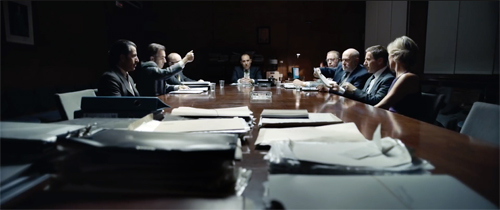


The Realm is a good example of how manipulating character attachment can strongly engage the audience. We know just enough to understand Manuel’s crisis, but without access to his mind, each scene can yield a surprise when he comes up with a new survival stratagem.
A lot from a little

I hadn’t really considered the Dardennes brothers “minimalist” filmmakers, but seeing Young Ahmed brought home to me how strictly they’ve limited their cinematic palette. Given their emphasis on actors and faces, you might think they rely on the sort of “intensified continuity” on display in modern film and television. Yet they’re far more purist than that, and they take objective presentation further than does Sorogoyen.
They seldom use long shots, let alone establishing shots: a scene starts in medias res with character action, shot from quite close. Filming in handheld long takes, they avoid shot/reverse-shot cutting, either panning between participants in a dialogue or simply framing them in tight two-shots.

The Dardennes minimize camera ubiquity. Not for them the picturesque, distant shots that The Realm sometimes provides. In a car carrying two passengers, the camera isn’t lashed to the hood or filming alongside; it’s in the back seat.
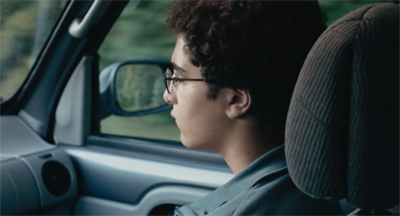
True, cutting yields some ubiquity. When Ahmed’s teacher pursues him through a classroom, she runs ahead of us but then, in the next shot, she catches up with him as he’s about to leave the building.
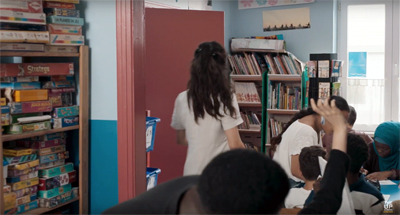

Like most cuts, it’s an instantaneous change of position that a real observer couldn’t execute. Still, this frame-edge cut creates simple continuity, driven by dramatic necessity and barely noticeable. The cut is softened by a staging that neatly settles into a standard over-the-shoulder setup.


Apparently uninterested in pictorial composition, these filmmakers simply center their subjects in undistinguished framings. No shot becomes strikingly lit or framed. There’s no nondiegetic music, and the soundtrack is subdued; of all modern filmmakers, they benefit least from surround channels.
As in The Realm, the Dardennes’ minimalist approach works well in tying us to the protagonist, while also denying us direct access to his mind. Ahmed, an adolescent in Liège, has given up video games for fundamentalist Islam. Convinced by his imam that his classroom teacher has become an apostate, he decides to take action against her.
His plans emerge wholly through his actions. Without benefits of voice-over, subjective sequences, or flashbacks, we must infer how he will respond to the demands of the Qu’ran as he has been taught to understand it.
The Dardennes’ objectivity doesn’t make the plot hard to follow. A dozen minutes into the film, the premises are clear, the main characters (Ahmed’s mother, his imam, his teacher) are delineated, and Ahmed’s motivation is established. At the half-hour point, his mission is launched. Apart from the ellipsis I mentioned, everything that follows stems from the dramatic premises. And however horrifying Amed’s plans may be, the wistful, pursed-mouth young actor Idir Ben Addi is mesmerically angelic. His glasses make him look adorable.
The style also keeps everything clear. The texture is close to that of documentary filmmaking, but of course the Dardennes’ films are scripted and staged. There’s a high degree of artifice in their apparently artless method. As in the more flamboyant Birdman, their long takes catch every reaction and gesture with great precision.
We always see what we need to see at just the right moment. When something is suppressed–here, the result of a violent knife attack–it’s not an accident (as if the camera were in the wrong spot) but rather the result of our attachment to Ahmed and a clever narrative ellipsis. We could have had a cut like the one in the school, but we remain with Ahmed, and in fact know a bit less than he does about the result of the violence.
All of which is not to deny the originality of Young Ahmed. All the Dardennes films seem modest, but they are, within their limits, quite ambitious in using dramatic psychology to probe social problems. Throughout, I think, we are asked to reflect on how firmly Ahmed believes in his version of Islam. Is it a transitory teen obsession or is he on his way to becoming a dogmatic martyr? We watch his behavior, his encounters with farm life and a young girl, for any signs that his lonely, taciturn demeanor will crack. In other words, this is a suspense film–one based less on the threat of violence (which is there, to be sure) than on how a boy who hasn’t fully formed his character will define himself.
Not such light housekeeping

Both The Realm and Young Ahmed are, to varying degrees, objective in their presentation. We must judge characters by what they do and say. Something very different is going on in Robert Eggers’ The Lighthouse. It too adheres largely to one character, but a battery of cinematic techniques, including camera ubiquity, works to plunge us into the man’s mind.
Although the film is a two-hander, it doesn’t balance viewpoints. Thomas Wake, an experienced lighthouse supervisor, arrives at his post with the novice Ephraim Winslow. Almost immediately we are attached to Winslow, who’s assigned grimy menial duties while Wake tends the beacon. Wake tells Winslow that his previous assistant went mad from the weeks of isolation, and very quickly Winslow struggles against the bleak, craggy island they’re on.
We’re prepared for an assault on your senses by the opening, when a ship roars out of the fog toward us. Thereafter, Wake subjects Winslow to a punishing routine of cleaning the cistern, heaving coal into the boiler, and scrubbing floors, while nightly meals with the nattering old salt are just as hard to bear. Winslow’s misery is rendered in vivid, expressionist terms. The deafening fog horns, thunderclaps, and boiler blasts are reinforced by stark, ominous black-and-white imagery. (The film was shot on 35mm film.) Winslow seems trapped in a world of raging elements and gigantic machines.




Eggers builds our affinity with Winslow through classic techniques. He watches Wake at the beacon from a distance; we get optical point-of-view shots of discoveries (real? imagined?) that start to unhinge him.


All the drudgery and pain, punctuated by Wake’s continual harangues and farts, lead Winslow into fantasies and hallucinations. His deterioration is rendered in shock cuts and distended compositions reminiscent of Welles’ Mr. Arkadin or German’s Hard to Be a God. Some will compare the film’s over-the-top climax to that of Aronofsky’s Mother!, but The Lighthouse, with its rapid montage and Gothic chiaroscuro, harks back to silent cinema. The fact that it’s shot in the 1:1.17 ratio favored by early sound film gives it an archaic feel as well. The dialogue, a late title informs us, is drawn from nineteenth-century sources, including Melville and Sarah Orne Jewett.
The Lighthouse has a cadence typical of modern horror films, but Kristin points out that it’s an expressionistic Kammerspiel too–a subjectively tinted drama setting very few characters in a constrained locale. Eggers shows that you can renew a genre’s appeals by reviving imagery from a classic period of film history. When you do it, you’ll still have to make fundamental choices about viewpoint and camera placement. They come with the territory.
We thank Alan Franey, PoChu Auyeung, Jenny Lee Craig, Mikaela Joy Asfour, and their colleagues at VIFF for all their kind assistance. Thanks as well to Bob Davis and Shelly Kraicer for invigorating conversations about movies.
For more on classic Kammerspiel films go here and here.
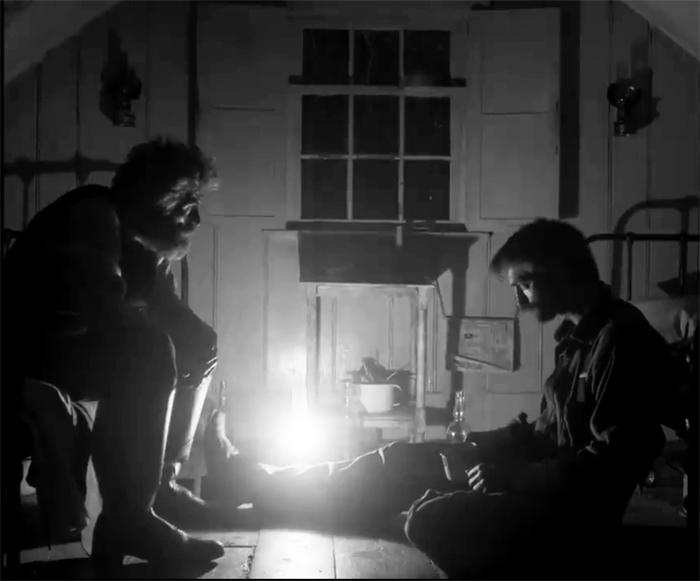
The Lighthouse (2019).
from Observations on film art https://ift.tt/2mVSYBX



